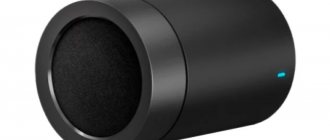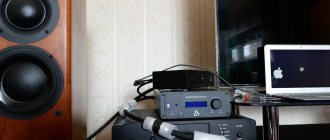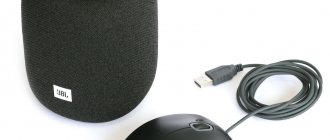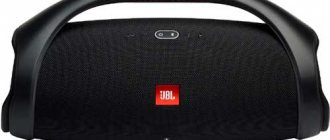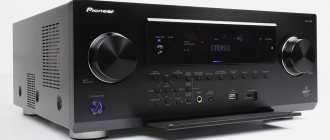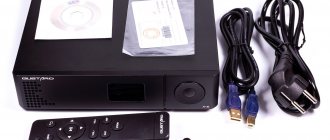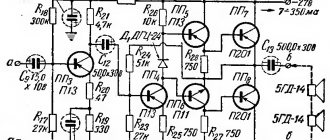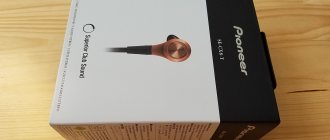In this rating we have collected the 8 best radio tape recorders in 2022. They come in two types - 1 DIN and 2 DIN. They differ from each other in size and the presence of a full color screen for viewing video content, which is important for travelers or those who spend most of their lives in the car. For an ordinary driver, a 1-din radio will be enough to play music. We'll talk about these today. They have undergone significant changes in recent years, getting rid of the CD drive. Modern radio tape recorders play music from a flash drive or smartphone via an AUX or Bluetooth connection, have a built-in FM receiver and can be controlled from a smartphone. Most are equipped with speakerphone microphones. If the functionality is almost identical, what should you pay attention to when choosing a radio?
- Number of linear outputs . The number of acoustic elements that can be connected and the ability to individually configure each pair depend on this.
- Presence/absence of a DSP processor . Digital audio processing improves its quality and allows the user to fine-tune the sound at all frequencies. With properly configured acoustics, many non-processor models produce high-quality sound, so overpaying is sometimes only advisable for audiophiles.
- Number of amplifier channels . With rare exceptions, radio tape recorders sold today are designed for 4 channels of 50 W, and this is an excellent indicator.
We tried to cover the needs of all users and collected models from different price segments in the rating, which are united by high build quality. When selecting, we took into account the opinions of sound experts and ordinary users.
Table of participants in the 1DIN car radio rating 2022
| Place | Name | Price |
| 8 | Sony DSX-A210UI | Yandex Market |
| 7 | JBL Celebrity 100 | Yandex Market |
| 6 | Prology CMX-230 | Yandex Market |
| 5 | KENWOOD KMM-304Y | Yandex Market |
| 4 | Alpine UTE-92BT | Yandex Market |
| 3 | Pioneer MVH-S520BT | Yandex Market |
| 2 | Aura 77DSP | Yandex Market |
| 1 | PROLOGY CMD-300 | Yandex Market |
Installation Guide
Universal connection diagram
Let's briefly talk about installing devices:
- First of all, the wiring is laid from the speakers to the center console, where the car radio will be installed. At this stage, it is advisable to familiarize yourself with the diagram that comes with the kit.
- The so-called shaft is installed in a special connector for the radio.
- After installing the shaft, you need to bend the steel petals, which are located at its ends or at the top and bottom. When bending them, do not damage the frame itself; use a screwdriver for this.
- After this, all connectors are connected to the car radio - power, antenna adapter, speakers, etc.
- The audio system is being installed in the shaft; when installing it, you must press down until it clicks.
- The operation of the radio is checked, and it is also configured according to the instructions.
Sony DSX-A210UI
4.7/5
20 reviews
Buy Yandex Market
average price
RUB 4,749
Characteristics
- outputs: audio output, PreAmp rear
- USB and AUX on the front panel
- rated power 4 x 20 W
- maximum power 4 x 55 W
- radio with RDS
- Connection:ISO/RCA
Opens my TOP Sony DSX-A210UI . The most technically simple device from a popular brand. Equipped with 1 line output and 4-channel amplifier with a power of 55 W. It will not be possible to build an advanced acoustic system on its basis without additional problems, and the technical capabilities of the device will not allow this to be done. A modest 10-band equalizer, FM receiver, USB, AUX inputs - all the functionality of a radio . There is no Bluetooth, there is not even a way to change the color of the backlight - it is red without any alternative, although it looks nice. There are sounds that work really well in tandem with the FB series speakers from Sony. One of the features worth noting is the ability to transfer music via USB from iOS devices, but a USB/Lightning cable will have to be purchased separately. Control - from the panel or buttons on the steering wheel.
Pros:
- Brand.
- Simple controls.
- Ability to connect IOS devices to USB.
- Sound quality for a processor-free radio.
- Reliability.
Minuses:
- Overpriced.
- 1 linear output.
- Functional.
- Heating during operation.
- Poor placement of function buttons; the flash drive blocks access to the track switching buttons.
- The encoder moves too soft.
- Cannot be controlled from a smartphone or remote control.
- No Bluetooth.
Price - from 6,000 rubles . In this case, we have a discrepancy between price and functionality. For 5,000 rubles you can buy a processor PROLOGY CMD-300 with enormous sound control functionality, a full-fledged crossover and 3 linear outputs, which can be used at your own discretion, expanding the standard acoustics or even replacing them. Don't need an advanced model? There are simple budget devices that can compete in sound quality.
For example, JBL Celebrity 100: costs half as much, has a built-in Bluetooth module, and a microphone for hands-free calling. Sony fans justify the high cost with the brand name and the reliability of the company's equipment. 87% of Yandex Market users recommend it. Personally, we are for a reasonable price and savings, especially in cases where it is really appropriate, which is why Sony becomes an outsider in our rating.
Reviews on Yandex.Market
Briefly about controllers
Pioneer DDJ-SB3 is a basic level controller for Serato DJ Lite. Equipped with assignable pads with Pad Scratch function. The cue and play/pause buttons are displayed separately. Effects are integrated into the deck. The controller is well assembled, although the body is completely plastic. The jog wheels are pleasant to the touch and are suitable for scratching.
There is a stereo RCA output, a headphone output and a microphone jack. The controller comes with the Serato DJ Lite distribution and also works with Serato DJ Pro if you want to upgrade to the advanced version.
DDJ-400 is a budget controller for the Rekordbox DJ program, which at one time replaced the DDJ-RB model. The DDJ-400 is slightly smaller than the SB3, and has a few significant differences. Firstly, it works with Rekordbox. Secondly, the effects section is integrated into the mixer, not the decks. Finally, the DDJ-400 has a convenient pitch fader.
The DDJ-400 has a minimum of connectors: one RCA, one headphone output and one microphone input.
Now let's compare the two controllers.
JBL Celebrity 100
4.7/5
37 reviews
Buy Yandex Market
average price
RUB 3,690
Characteristics
- outputs: audio output
- USB and AUX on the front panel
- Bluetooth
- connecting a smartphone on iOS, Android
- radio
- rated power 50 W
Seventh place goes to JBL Celebrity 100. Winner in the “economy” category (price - from 3,000 rubles). It is not significantly inferior to expensive models in any of the criteria. 4 channels of 50 W. In terms of settings, everything is modest, like all processor-free radios - frequency adjustment with a built-in ten-band equalizer, several presets for individual music genres, and such opportunities are enough for the average person. In terms of functionality: there is an FM receiver, AUX, USB, Bluetooth and a built-in microphone for hands-free calling . There is also a slot for SD cards under the external panel - none of the competitors in the rating can boast of this.
The device reads MP3 and FLAC formats without problems, but unlike expensive competitors, WMA and ACC are not supported . Today these formats are not very common, and if necessary, you can decode them into mp3. The design of the model is modest, not much different from its more expensive competitors in the rating . The backlight color has no alternative - red, but this cannot be considered a disadvantage of a budget radio. If this parameter is extremely important when you need to save money, pay attention to the Prology CMX-230: you may even be able to save a few hundred rubles.
Pros:
- Price.
- Sound quality.
- Easy controls and settings.
Minuses:
- Tight plug for USB connector.
- Does not remember radio stations after turning off.
- Panel play.
- 1 linear output.
- Some users lack a good equalizer.
- There are no alternative control methods.
An excellent option in terms of price-quality ratio . The stated disadvantages are very conditional considering the price tag. In practice, only car audio enthusiasts actively use the equalizer, and most often it is the sound settings that are made from a smartphone, which in this case is irrelevant due to their scarcity. For those who need the ability to control from a smartphone, the Prology CMX-230 is suitable. If you are looking for sound quality and the possibility of individual settings, we recommend taking a closer look at processor-based radios, although you will have to pay at least a couple of thousand rubles.
Reviews on Yandex.Market
The world's first plasma TV
In 1992, Pioneer engineers turned to plasma technology, which led to the appearance in December 1997 of the world's first 50-inch high-definition plasma panel PDP-501HD (Plasma Display Panel), which created a real sensation in the video industry and largely determined the technical characteristics and design modern flat panel televisions.
PDP-503HD
Prology CMX-230
4.7/5
47 reviews
Buy Yandex Market
average price
2,800 rub.
Characteristics
- size 1 DIN
- USB and AUX on the front panel
- Bluetooth
- iPhone support
- radio
- rated power 55 W
Sixth place is occupied by Prology CMX-230 . The most budget radio in the rating costs less than 3,000 rubles. There is no need to talk about the processor here. But there is a 10-band equalizer with 4 presets and the ability to customize. The capabilities are noticeably more modest compared to processor-based radios. You cannot adjust the volume of the subwoofer - only turn it on or off, the same applies to loudness compensation (two modes - “on” and “off”). But compared to competitors above, there are already 2 pairs of RCA and the ability to change the backlight color, and in all colors. Standard functionality - USB, AUX, FM, Bluetooth.
Control - standard panel, included remote control and smartphone - most users like the application interface , functionality is not limited - you can control all functions of the radio. CMX-230 is the standard of appearance in the budget segment. We would compare it with the Pioneer MVH-S520BT, which costs 4 times more: spectacular backlighting, a large bright display, an interesting solution with a plastic curtain covering the AUX and USB connectors. The latter is highlighted - it looks beautiful + indicates the location of the port for those who are just starting to use the device.
Pros:
- Price.
- Design.
- Simple controls.
- Control from a smartphone.
- Interface and usability of the application.
- Remote control included.
- Sound quality and number of settings for a budget radio.
- Backlight control across the entire color spectrum.
Minuses:
- Doesn't read track names in Cyrillic.
- 2 linear outputs.
- There is no section on flash drive folders, reads all tracks in a row.
- You cannot control the steering wheel buttons.
An excellent model for its price . Suitable for the average person without pretensions to audiophilia. The sound is good, but there are few fine-tuning options. Not suitable for car audio enthusiasts. They should consider processor models, but also take into account that they are at least twice as expensive and quite difficult to set up. We consider PROLOGY CMD-300 to be the optimal price-quality ratio.
Reviews on Yandex.Market
Final choice
Both controllers are suitable for beginners, both have excellent jog wheels and decent functionality. But they still solve different problems. If you want to learn how to scratch and master Serato DJ, the DDJ-SB3 is your choice. This is Pioneer DJ's best solution for Serato so far, the controller is tactilely comfortable and the necessary functions are at hand. And if you need to get ready for the club and switch to Rekordbox DJ completely, consider purchasing the DDJ-400. The controller interface replicates the ergonomics of a professional segment device, and a firmly established skill in handling club equipment is guaranteed to help you not get nervous during your first real sets and not get distracted.
We hope that the points highlighted in the material will help you choose the controller that will bring your skills to the level you need.
KENWOOD KMM-304Y
4.4/5
32 reviews
Buy Yandex Market
average price
7,625 rub.
Characteristics
- outputs: audio output
- USB and AUX on the front panel
- Bluetooth
- Connection:ISO/RCA
- radio with RDS
- rated power 50 W
Fifth place goes to KENWOOD KMM-304Y . An advanced device with a DSP processor and a 24-bit DAC on board. 8 fixed presets and a 13-band equalizer expand the possibilities of sound adjustment, including frequency cut, channel delay and much more. Proprietary sound improvement technologies are also interesting: BassBoost, Sound Realizer, Stage EQ - correction of high, low frequencies and bass at different volume levels. According to many car audio experts, this really works, which is confirmed by tests performed in professional recording studios.
The maximum power of connected acoustics is 200 W (4 channels of 50 W each). ISO/RCA connection - 3 line outputs. Features - USB, AUX, FM, Bluetooth, change the backlight color . Controls - buttons + encoder on the panel itself + steering wheel buttons. The model is Russified, although not very high quality, but it is easier to adjust the sound on it. Price - 7,000 rubles.
Pros:
- Price-quality ratio.
- Sound quality.
- Sound customization options.
- Russification.
- Fully adjustable RGB lighting.
- Proprietary sound compensation technologies at different frequencies and volumes.
Minuses:
- Cannot be controlled from a smartphone.
- It gets very hot.
- Stainless plastic.
- There is no MUTE key.
- There are problems connecting Xiaomi smartphones.
- Sound deterioration when using delays.
Not a bad option, but the closest price competitors with similar functionality - Aura 77DSP and PROLOGY CMD-300 - heat up less, show better crossover performance and time delays, have no bugs with connecting Xiaomi devices, support control from a smartphone, and are also cheaper. Summarizing all these factors, we recommend choosing them.
Reviews on Yandex.Market
Review test comparison of processor radios from Pioneer, Kenwood, JVC, Alpine.
Review test comparison of processor radios from Pioneer, Kenwood, JVC, Alpine.
Hello, dear subscribers, I am with you again, Peter Butikar. And today, by popular demand, we will finally have a video test, where we will compare budget processor-based car radios from different manufacturers. And here are the heroes of our test. By the way, despite the fact that the test came out a long time ago and the radio models can be considered outdated, even the 2020 model range still has many of the same features, so this test can safely be transferred to modern models (except that the Pioneers began to have a slightly better sound , but a slightly less convenient menu).
Unlike many other printed resources, today we will compare not only how well one head unit sounds in relation to another, that is, we will actually have a battle, but, at the same time, we will also see how car audio works on these head units CPU. The fact is that the functionality of the audio processor can be completely different. And, believe me, it is completely different on these head units. And one of the functionality of the processor of any head unit can allow you to make and configure a high-quality and competent music system. And some other devices may have some kind of audio processor on board, but it will not be enough to conveniently, without any nuances, make and configure high-quality and competent car audio. Therefore, today we will also listen to all four of these devices, but in fact there are more devices, but more on that a little later. But we’ll also see what limitations this or that device has in the settings. In fact, we will have such a tour of a whole bunch of models at once. And all at your request. And before we test and compare all these devices, I will tell you which test participants we have. I will also indicate the approximate cost of these devices and some specific nuances and additional information.
So, let's start our today's test review and comparison with the currently most famous budget device, which has an audio processor on board. This is Pioneer 580. Also known as MVH-X580BT.
I have already configured and built a very large number of cars on this head unit. A budget head unit, naturally, is not Hi-End, but it copes well with its functionality for an entry-level device. I already know everything about the nuances of this device, but at the same time, even for me it will be a mystery and is of interest whether the Pioneer 580 will play better than Kenwood, JVC or even the more expensive Alpine. Therefore, for me this test will be of personal interest, the same as for you.
But, before saying anything about the 580, I also want to tell you that the absolutely same processor and DACs, analogues of this head from Pioneer are produced under different names. For example, MVH-X580BT has an analogue to S5000BT, which differs only in the presence of a CD drive, while all other functionality is the same. And also this head unit has a similar 2-din device called FH X 730BT. That is, when testing the Pioneer 530, we will test both the S5000BT and the FH X 730BT.
Please note that 2-din multimedia head units, as well as Pioneer 80 and 99, have different processors on board and play completely differently. Therefore, this test will be relevant only for the three devices that I have listed.
The second in line will be this device, which we will compare and listen to.
This is Kenwood KMM-BT304. I can immediately say that this device has complete analogues. The device with the disk for this Kenwwod is called KDC-X5100BT, and the 2din version will be called DPX-5100BT.
That is, while testing this device, we are immediately testing two more from Kenwwod.
And as for the JVC device. Today we have the KD-X352BT model, but it also has absolute analogues with the same filling.
Copies of this device are called: with disk JVC KD-R992BT, 2din version JVC KW-X830BT. So, testing it. We will also be testing two other models.
As for an expensive toy, it is relatively expensive, since this device is more expensive than Pioneer, Kenwood, JVC, but it costs little money. This is Alpine CDE-193BT.
It is disk-based, but has a diskless counterpart, which, by the way, is more popular: Alpine 92 bt. However, they do not differ in anything except the presence of a disk. Nobody needs a disk lately, but you never know. I bought it at the Auto Hi-Fi store. A similar model will be called UTE-92BT. And 2din analogue of CDE-W296BT.
We will look at this device at the very end, since it is the most expensive. Let's start with simpler devices and comparisons with them. And we will test all these car processor radios in a very interesting way. The very first thing we will find out is which of these machines plays best. We will take each device, run it on the same path, one composition, at the same volume. I will write all this down for you, and you can compare. And I myself, being here, will already listen to this. You yourself understand that the characteristics of this microphone, your speakers, can easily distort what I hear here, and what you will hear at home. But there is me and I will draw certain conclusions and tell them to you. And then the choice will be yours.
Therefore, having carried out an initial test, simply listening to everything in the same path, we will already have an idea which of these head units plays better on its own. Therefore, having carried out an initial test, simply listening to everything in the same path, we We will already have an idea which of these head units plays better on its own.
But here you need to take into account a nuance. In all head units, I will completely turn off all sound settings, that is, they will work in a wide band in their purest form.
And in the future we will take each of these devices and see how its sound settings affect the sound quality of each specific device. And in general, are these sound settings enough to get high-quality and competent car audio in your car?
To begin with, we have a purely musical test, and then we will sum up the results, because if we find a head unit that really plays better than others, but at the same time its processor is safe, then there will be little sense from this device as a processor radio. But at the same time, this head unit will have a certain potential to be used in conjunction with an additional external processor.
We are moving on to listening to all the devices now, and in my mode I will listen to first one device, then the second. Instant switching only between two devices, since my equipment only allows this. I will install and configure it for you in such a way that you will see everything in one context. We will edit it for you so that you can see it all as if it were an instant test. I took Pioneer and Kenwood, I will compare them with each other, then I will change the leader to the next device, and I will change the next leader to the next device. And thus, it will be clear which of these devices is better, which is worse, what are the features and how much of a difference there is. I switch between devices instantly, so if there is a difference, I will hear it immediately. And after we identify the leader in sound quality, we will look at what processor features each device has.
So, we have two devices - Pioneer and Kenwood, then Kenwood will be replaced with all the remaining devices, for me personally the Pioneer will remain as a sample for comparison, since it is the most popular at the moment, perhaps undeservedly.
And you will see all this already mounted. My microphone is in the same place, it works from the same pair of speakers.
Here we have German Maestro playing from the Concept series. All this works through a Hertz amplifier. So, Pioneer and Kenwood. And Elton John will play the song “Nikita,” one of my favorite songs. I’m ready to answer you that Kenwood’s socket itself is the nicest in terms of workmanship, while Pioneer’s is still in second place. JVC's socket looks the simplest. So, we listened to all four head units, I listened to them much more than you, and I’m ready to come to conclusions that were unexpected for me. I compared all the devices with Pioneer, because it was convenient for me for switching. First, JVC is simpler than Pioneer, it plays worse in bass, much less detailed, in the midrange, and in the treble. It is inferior to Pioneer in everything. Not much, but inferior. With all this in mind, JVC sounds simpler. It's cheaper and you can hear it in the sound. If you install Pioneer, you won’t hear any wild gains, but there will be some.
As for Kenwood. In the midrange, Kenwood plays at absolutely the same level as Pioneer. The main range that a person perceives is the midrange and here they are practically indistinguishable. As for the high-frequency range, the Kenwood sounds a little simpler, less detailed, but the Pioneer has some kind of peculiarity - that at the high-frequency level it somehow makes noise, so to speak. A little more sebilents, some incomprehensible artifacts, which in their total mass create an incomprehensible veil of noise. Kenwood does not have this, that is, the highs sound simpler, but at the same time, due to the fact that this effect is not present, it looks better at the highs. The Kenwood lows are more delicate, or rather, not to say strong, but significant. So from this point of view, for now I would put Kenwood in first place, Pioneer in second and JVC in third. Moreover, according to the schedule that you now see. That IMHO ButiCar scale.
As for Alpine. I have said many times that Alpine is an extremely specific brand and it is sold specifically here, as well as throughout the world. Most things under the Alpine brand, unlike competitors, have a higher price. At the same time, they are much worse in terms of quality indicators than their competitors. In other words, Alpine is more expensive and worse. And these two criteria are combined simultaneously in Alpine. This applies to almost any Alpine branded product. But here our situation is different. I don’t know what rooster pecked them, or what happened to them, but this Alpine head is naturally more expensive than the Pioneer or Kenwood one. But in terms of sound it is in another higher class. At the same time, if we compare with Pioneer, then the tops are approximately at the same level, but without these artifacts that are present on Pioneer. The Alpine's bottom end is about the same as the Pioneer's. But in the midrange, and this is the most important range, Alpine is already in a completely different class. That is, one can put it this way: Pioneer, JVC, Kenwood are Hyundai, Solaris and Kia Rio, then Alpine is already Sonata.
In fact, taking all the circumstances into account, in terms of sound, in terms of direct conclusion, I will definitely give Alpine first place by a landslide. I’ll put Kenwood in second place, much behind Alpine, but not far behind Pioneer. And JVC is in the lowest place.
But, you and I know very well that it’s one thing how the device plays according to direct output, and the second thing is how they can be configured in a car and what can ultimately be squeezed out. And that's exactly what we'll do now. We will take all the devices, look at the sound capabilities that each of them has, and what will come of it. For now, by direct conclusion you can see my sign, let's see what it turns into after considering the sound capabilities of their processors. And here our sign can turn completely over. But! What will this plate be good for? The thing is, very often I see situations where people use a standard head unit and an external audio processor. And precisely if you use an external audio processor with these head units, this plate will be most useful for you. Well, if we, as it should be logically, buy these head units in order to use a processor in them, then everything can turn upside down, so let’s see what functionality each head unit has and what we will end up with if we We want to build a high-quality and competent audio system.
Before we talk about the capabilities of a particular device, let's talk about what every audio processor should be able to do. I already had a video regarding this issue.
In general, each of these head units allows you to tune, that is, configure only a two-component speaker system plus a subwoofer. Which is what is needed for most budget systems. The processor must be able to set the slope of the cut for each of the speakers, it must select the frequency of the slope of this cut, cut the speaker from below and from above each - tweeters, midbass, and subwoofer (in our case, since for two-way speakers, then midbass). At the same time, he must set a delay on all channels, and the greater the delay, the better, since cars can be of completely different sizes and there are subwoofers, especially budget ones that are extremely slow, to which you really need to set a very high delay in terms of values. Each audio processor must be able to adjust the volume of each individual speaker. It is very important. Naturally, for ease of setup, it must be able to reverse the phases on each individual speaker, that is, separately on the left tweeter, separately on the right tweeter, or in pairs of them. Each speaker must also be able to “muddy”, that is, completely turn off the sound from it. Not lowering the volume, for example, by dicibels, turning off the volume of an individual speaker, but turning it off instantly. For example, you need to adjust the midbass - it is advisable to have the tweeters and subwoofers turned off for the initial midbass adjustment. Some audio processors do not allow this. Therefore, this moment also concerns us. And in general, we are concerned about whether the sound quality will change if we start using audio delays and other settings on each tape recorder. And it’s also important how the equalizer works on each head unit. Looking ahead right away, I’ll say that it works disgustingly on Pioneer and you need to use it specifically. As for other head units, now we will take a look.
Therefore, let’s move to where I have a JVC and try to climb on it, since the most surprising thing is that the instructions in no way reflect what this JVC shows us in reality.
So, JVC. Let's move straight to the issue of delays. I’ll say one thing right away – that its delays work correctly, no changes in sound quality occur. At the same time, the maximum distance that it allows to display is a little more than five meters. This is more than enough for any car and for the correct setting (even 610 cm). Next, from the advantages that also exist here. This is that we can select a separate gain for each individual speaker. And one more small positive point is that this head unit also provides for the fact that we can change the phase in pairs for each pair of speakers. The slope of the cutoff for all speakers here is either first or second order. As for the equalizer of this head unit, at any frequency when increased to plus 2 everything is in order, if higher, then there are some distortions and artifacts. And up to minus 4. That is, from plus 2 to minus 4 on JVC you can safely work with the equalizer.
Now we'll move on to the Pioneer settings.
So, the first thing I would like to say is. It is in Pioneer that you should never use the equalizer (or use it carefully). Moreover, if we start working with it from 500 Hz and above, then both the minus and plus values spoil the sound very much. The only thing that is not so noticeable is when we start minus, that is, reduce the volume of a particular frequency in the range up to 315 Hz. In the range from 50 to 315 Hz to minus 2-3 values, negative changes in sound are not so audible. Perhaps they are there, but are not felt by the ear or are not felt so strongly. In fact, there is no equalizer in this head unit. But in the range of 50-315, in some cases it can be useful precisely for minus these frequencies. Those. in order to make them quieter. And you can use this. But nothing more.
According to the main features that this device has. As for the speaker volume, this unit allows you to change the speaker volume separately for the left tweeter and separately for the left tweeter. Separately for the left midbass, separately for the right and subwoofer. This is an extremely useful function, which is very useful for setting up a competent system. The downside of this device is that it cannot completely turn off the speaker. If you need to adjust the midbass and even lower the gain with the tweeters, they will still work. Therefore, you will have to run to the trunk and disconnect the tulips from the amplifiers, not forgetting to turn off the tape recorder in order to turn off the HF and adjust the mids or vice versa. Regarding the crossover: here it is more than logical and understandable. The cutoffs are installed separately on the tweeters, and the slope of the cutoff is set from 6 decibels per octave from the 1st order to the 4th. The same goes for the midbass – you can cut them up and down in different orders. In this case, the maximum order will be 4th. But what’s nice is that on the subwoofer the order you can operate with will not only be 4th, but also 5th and 6th. This can be very useful in setting up music systems. The downside is that there is no subsonic, that is, the subwoofer cannot be cut from below. That is, there is no high-pass filter for the subwoofer here and this is a minus. For example, Pioneer 99 has such a function, as do most external audio processors. There is none here.
Next, again, nuances, which, by the way, will affect absolutely all tape recorders - all four. The fact that you cannot install different cuts on pairs of speakers. If the left tweeter is cut at 2.5 kHz, then the right one will be cut at the same frequency without fail. On more modern external processors and on more progressive radios, such as the 80th or 99th Pioneer, there is such an opportunity. All four devices we have do not have this feature. By the way, subsonics, that is, trimming the subwoofer at the bottom, is also not present in all four devices. It is also not present in this head unit. In it, we can easily change the phase of the subwoofer, but we cannot change the phasing of the speakers. We cannot reverse the phase on tweeters, even if not just one, but two. We can't change the phase on the midbass either. Often this can be inconvenient, because if something is messed up somewhere, and it would be better if something played out of phase, for example, then we will have to mechanically twist the speaker cables. Because this is not provided here. As for the delays: they are more than logical. But, again, there is not the most pleasant nuance. This is the situation regarding delays. The fact is that the maximum delay that Pioneer allows is 350 cm on any channel. In fact, the subwoofer is the farthest speaker we have when setting it up, and the trick is that often 3.5 meters will not be enough with the correct phasing of the subwoofer on the vast majority of cars.
In principle, for a closed box and a Hyundai GETZ 3.5 m is usually enough, but for some sedan and speakers on a bass reflex box these values will no longer be enough. Therefore, on the Pioneer 580 the subwoofer is tuned out of phase, then the subwoofer delay values will be completely different. Perhaps 155-200 cm, much smaller. This is acceptable, although not entirely correct. But, nevertheless, this is the only way to do this in this device.
Let's move on to the Alpine settings.
Let's move straight to the equalizer. The situation is this: if we work it at a disadvantage, then it works quite adequately, without any serious changes in sound quality, but this is only a disadvantage. We choose some frequency that we want to change, in fact, if we work in minus down to minus 6 decibels per octave, no negative changes are heard. But, if we make even one positive change, at any frequency, there is immediately a strong deterioration in sound quality. That is, I strongly recommend using the equalizer on this device exclusively to the minus level. As for the crossover. In this head unit it is quite successful in three-way mode (two-way + sub). It can cut up to the 4th order of up to 24 decibels per octave tweeters, midbass, top, bottom and also subwoofers. I repeat, there is no subsonic in it, just like in Pioneer. The maximum cut order for subwoofers on top is 24 decibels per octave. But there are also disadvantages. You cannot change the volume level of an individual speaker; you can only change the volume level of two tweeters at once. This is very inconvenient, we will talk about this later. This is the main drawback of this device. It also does not allow you to change the phasing of the speakers. That is, we can change the subwoofer phase, but not the phase of the tweeters and midbass. You will have to run to the trunk even if during setup it turns out that this is necessary.
The main feature of this device is its delays. Let's say we have a front left speaker, we display the maximum delay and it will turn out to be this value.
Then we go to the front right tweeter, start increasing it, it turns out 173 cm. Look, 366 cm and 173 cm. These are the maximum delay values for all six channels of this head unit. Approximately somewhere a little more than five meters is the total delay for all channels. And it's very inconvenient. And in some situations it can play a negative role. The best one in terms of sound turned out to have the most unsuccessful, specific and reduced delays.
One more point about Alpine. Changing delays and setting crossovers does not degrade the sound. Only using the equalizer plus there are negative changes. In all other modes, like Pioneer, everything is clear and normal.
And let's move on to the Kenwood settings.
This device absolutely seamlessly sets any cuts to tweeters, midbass, and subwoofers in the desired frequency range. Like all our other devices. But there is a small nuance. All speakers can be set to either 1st order or 2nd order cutoff. Including the subwoofer. This is again inconvenient. The following are positive nuances that can be noted. It also allows us to easily adjust the volume of each individual speaker, which will be necessary when properly setting up the audio system. Another nice feature is that the maximum distance that can be set is 610 cm of delay. This will be decent even for a decent-sized minibus. It also allows you to change the phase of all pairs of speakers. Now comes the fun part. When working with delays, certain adjustments are made to the sound quality. You need to pay attention to this.
So, as far as sound quality is concerned, I would distribute all our devices according to our scheme. But it will be much more interesting to find out what happens if we add to this plate the capabilities of the audio processor in these head units.
So, I can immediately note that all of our four head units have their own specific disadvantages, which are not the same for all of these devices.
First. This is the absolute inability to trim the subwoofer speaker from below, that is, a CPF filter on the subwoofer or, in other words, a subsonic. For example, Pioneer 99 has such a function, as do most external processors. Unfortunately, our head units do not have such a function. And the fact is that if you use a monoblock subwoofer, then most likely there will be a subsonic there. But, if you have a 2- or 4-channel amplifier playing on your subwoofer, or some individual models of monoblocks, then this subsonic may not be there. And this can play an unpleasant role in the setup.
The second unpleasant feature. Many processors have a function with which you can completely turn off one or another speaker, or a pair, or several speakers. Unfortunately, none of these head units can do this. If you only need to adjust the midbass, then adjust the tweeters, then you will have to run into the trunk and disconnect the interconnect cables from the amplifier in order to completely disconnect one or another link. The only thing this doesn't apply to is the subwoofer. On all devices the subwoofer can be turned off. As for the rest, you will have to run. In this case, an external processor will be optimal. But they cost completely different money. Therefore, for fairly budgetary funds, you can run into the trunk.
Let's move on to the next nuance regarding the audio processor. To functionality that is not found in any of these radios. What you can't do is set different cuts on each pair of speakers. For example, you want to cut the left tweeter to 2.5. kHz, the right one is a little higher. None of these radios will allow you to do this. It’s also inconvenient, but you can live with it. Next point. You cannot separately change the phasing for a single channel. On some of these devices, you can change the phase of only a pair of speakers, but you cannot make it so that the phase, for example, on the right tweeter was one, and on the left it was different. That is, the left is in phase, the right is out of phase. What is it for? If you configure the audio system correctly, you do not need such functionality, but, as practice shows, it happens very often, and such machines constantly come to me for tuning, where simply one of the tweeters is out of phase. So I'll have to go into the trunk and physically twist it. If such functionality existed, then I would only have to press one button and not have to run anywhere. This is in many cases, and for me, as a tuner, it is a disadvantage. And the next nuance. None of these head units allow you to use an on-board equalizer. Make an equalizer separately for the left side, separately for the right, or for a separate speaker. You can also live without this, but such functionality would not hurt. But what do we want for these budget funds? Now let's move on to what the pros and cons of each of their head units are. As for Pioneer, its main negative feature in relation to other head units is that they can change the phase of a pair of speakers without leaving the cash register, that is, in the tape recorder settings. In Pioneer this can only be done on the subwoofer. In Kenwood and JVC we can change the phase of tweeters or midbass at the same time, but in Pioneer and Alpine we cannot do this. Here is a nuance that plays a role in setting up the audio system. This problem can be solved very easily - run into the trunk and twist a couple of tweeters at once and check how it will be better. But in fact, the solution made by JVC and Kenwood is much more convenient, where you can switch this in just a second using the settings of the head unit.
The next item is all four head units. It will not be in favor of Alpine. Pioneer, JVC and Kenwood allow you to change the volume of an individual speaker. We can set the volume separately on the tweeter and on the midbass, and separately on the left tweeter and on the right. You can't do that with Alpine. And this is the creepiest thing. It turns out that this nuance is extremely inconvenient and will give us the most problems when setting up a music processor system. How can this be cured? Still, Alpine plays better than everyone else and I would like it to be superior in settings to other devices, so that every penny that was invested in it would be justified. Unfortunately, there is only one way to do this. The first is by changing the balance, that is, moving the volume of the left and right sides a little to the right, a little to the left. In most cases, when making adjustments, we are forced to move the balance to the right in order to make the right side louder, which itself usually plays quieter. But the trick is that often the volume for tweeters and midbass will be different. For example, we need to set the volume on the left tweeter to minus 5, to the right zero, and on the left midbass minus 1, to the right zero. And this is where we will have problems. There will be some volume inconsistency between channels. I found only one solution to this problem for myself. I use resistors that cost nothing and can be selected separately for each speaker. I have a whole box of them.
And simply hanging them on the left tweeter, change its volume differently than it will change, for example, on the left midbass. This is the only solution that can be used with this head unit so that it works correctly. This is also extremely inconvenient. But we already realized that all these head units and the audio processors in them are far from ideal.
Alpine UTE-92BT
4.8/5
59 reviews
Buy Yandex Market
average price
RUB 19,990
Characteristics
- outputs: audio output, PreAmp subwoofer, PreAmp rear, PreAmp front
- USB and AUX on the front panel
- Bluetooth
- Connection:ISO/RCA
- radio with RDS
- maximum power 4 x 50 W
Fourth place goes to Alpine UTE-92BT . The 2016 model, which still remains the sales leader, even despite the increase in cost recorded by Yandex Market statistics. What is the reason for the popularity?
- High-quality 24-bit digital-to-analog converter.
- 4-channel amplifier with a power of 50 W per channel.
- Control alternatives - an application on a smartphone (Android/IOS), buttons on the steering wheel or a remote control (not included).
In addition, the device boasts a 9-band equalizer, 10 preset presets, the ability to fine-tune the sound , including frequency filters, and a bass boost function. The acoustics are connected via 3 RCA outputs. Functionality is classic: AUX, USB (inputs on the front panel), radio and Bluetooth. It is possible to select the color of the button and screen backlight. Despite the high price - about 18,000 rubles, the design of the model is uncomplicated , the quality of the display is no different from public sector phones, and the controls cause complaints from some users. There is a complex menu (an alternative is that setting up from a smartphone is easier), the absence of a mute button when there is a built-in microphone for conversations, hard buttons that click loudly, and an insensitive encoder. Some users are satisfied with the usability of the model.
Pros:
- Sound quality and fine tuning.
- Alternative management methods.
Minuses:
- Overpriced.
- Display quality.
- Some users don't like usability and ergonomics.
- Bluetooth does not automatically connect when the phone is within range.
- The remote control is not included.
- Some users don't like the usability of Android apps.
94% of Yandex Market users recommend it, the absolute majority - with the highest rating . Overall, the model is not bad, but its price is clearly overpriced. For example, the 25-band equalizer Aura 77DSP with a price tag three times lower gives the user greater freedom in choosing settings. Yes, for many ordinary people this is too difficult and they simply do not use most of the features, but the radio for 5,500 has more of them than the model for 18,000 rubles. In terms of sound quality, these models can be put on par, why pay more? This issue pushes Alpine to 4th place in the ranking. If you are going to pay for the brand name and quality, then it is better to choose the Pioneer MVH-S520BT.
Reviews on Yandex.Market
Loop section
This is where the DDJ-400 takes the lead, as the interface mimics more expensive pro-segment CDJ players. The buttons are quite large. The controls are simple: a 4-beat auto-loop can be turned on with one button. The re-looping function and changing the loop length have their own buttons; they can also be used to launch already saved loops.
In DDJ-SB3 everything is more modest. There is a large autoloop button and one button each for changing the loop length multiple times. DDJ-400 with the functionality of professional controllers inevitably wins.
Pioneer MVH-S520BT
4.7/5
53 reviews
Buy Yandex Market
average price
14,500 rub.
Characteristics
- outputs: audio output, PreAmp rear, PreAmp front
- USB and AUX on the front panel
- Bluetooth
- Connection:ISO/RCA
- radio with RDS
- maximum power 4 x 50 W
The top three is opened by Pioneer MVH-S520BT . In the opinion of our editors, this is one of the most attractive radio tape recorders in terms of design and usability - glossy plastic, small buttons with a soft stroke and the ability to adjust the brightness and color of the backlight in the entire color spectrum, a smooth encoder, a separate button for answering calls, a bright Russified display, synchronization with buttons on the steering wheel, control from a smartphone (Android/IOS) of all sound options. 13-band equalizer (31 bands available when configured from the smartphone application), frequency filter, bass boost .
Users note the convenience of the Pioneer Smart Sync application. Control capabilities are significantly expanded and simplified thanks to a convenient graphical display of the adjustable parameter. It is possible to save several user presets for later inclusion on the radio control panel. Functionality - USB, AUX, Bluetooth, FM receiver, microphone for speakerphone . The radio is designed for 4 channels of 50 W each, connection - ISO/RCA. Price - 13,000 rubles.
Pros:
- Design.
- Dimmer - dims the backlight in the dark.
- Great options for customizing sound.
- Sound quality.
- Ease of use.
- Features and convenience of the smartphone application.
Minuses:
- Bluetooth lags with older smartphone models.
- For Yandex services to work correctly, you need the latest firmware.
- The quality of the microphone for hands-free calling does not satisfy all users - the sound quality is poor and there are delays.
A model for visual learners and audiophiles. A successful combination of design, as well as materials and build quality with wide sound customization options. The price of 13,000 rubles is justified by the name of the brand . If you are not ready to spend that kind of money on a radio, there are decent domestically produced radios that have become leaders in the rankings due to their balanced price-quality ratio.
Reviews on Yandex.Market
Effects
The effects section is where the main differences between controllers lie. In the DDJ-SB3 it is traditionally located on the decks. In the DDJ-400, they decided to output the effects to the mixer, on the right hand, as is done on stand-alone consoles. Visually and from an interface point of view, the DDJ-400 looks like a standard two-deck setup with a mixer. But in this case, you will have to assign effects manually to each deck. There is no need to do this on SB3.
To launch effects, a large blue button was added, which is more convenient than the SB3 buttons. However, you still won't be able to select effects without looking at the screen. As for the SB3, each deck is equipped with 3 effect buttons, you can select up to 3 effects at the same time. Only one effect can be active on the DDJ-400.
From the perspective of the effects section, SB3 is perhaps more convenient.
Aura 77DSP
4.8/5
4 reviews
Buy Yandex Market
average price
5 300 rub.
Characteristics
- size 1 DIN
- USB and AUX on the front panel
- Bluetooth
- Connection:ISO/RCA
- radio with RDS
- maximum power 4 x 50 W
In second place is Aura 77DSP . One of the best budget radios according to many experts. For just 5,500 rubles, the manufacturer offers us functionality worthy of premium devices, with a price tag several times higher. On board is a DSP processor that allows you to adjust the equalizer settings with a high level of precision : 25 bands (there are both preset presets and the ability to fine-tune the sound in general and each channel separately, including sound delay). This affects the quality of sound perception and adds individuality, taking into account the musical taste of the owner .
4 channels with a power of 50 W each, when choosing the right acoustics, provide excellent sound . For connection, 3 pairs of RCA connectors are used. 4 operating modes - AUX, Bluetooth, USB and FM/AM radio, AUX and USB inputs on the front panel. The USB player supports FLAC, MP3, WAV, APE, AAC formats, and there are no lags observed when playing any of them . Control - a button panel with an encoder for selecting adjustments, a remote control or an application on a smartphone. The functionality of the latter is not limited - all radio options are available, and there is an application for IOS . The design and assembly materials indicate that the radio belongs to the budget segment: angular shapes, inexpensive plastic, loudly clicking buttons, a simple RGB display, although with the ability to adjust the backlight color.
Pros:
- Wide settings.
- Trouble-free reading from a flash drive of the declared formats.
- Remote control included.
- Control from Android smartphone and IQS.
Minuses:
- There is no microphone for speakerphone.
- The buttons click loudly.
- When installing powerful acoustics, the minimum volume level may be high - you will have to cut the frequencies.
Top in terms of price-quality ratio, the main thing is to correctly calculate the power of the acoustics, taking into account the size of the cabin. The lack of a microphone for speakerphone is a problem with many budget processor radios. However, there are options here too: for example, the leader in the rating PROLOGY CMD-300 has a good built-in microphone.
Reviews on Yandex.Market
PERSONAL EXPERIENCE
The interface of the control program is unusual, but intuitive and convenient; all positions are well thought out and grouped by purpose. Since control is via Bluetooth, the smartphone does not have to be attached to the device - it can be located anywhere within the cabin, turning into a convenient remote control. You can also use a USB connection, but for the application to work, this mode must be set in the receiver settings. Without this, USB will only charge the smartphone.
After preliminary setup and selection of modes, you can use the device without a smartphone, but with limited capabilities. Quickly switching equalizer presets from the panel is not available, not to mention adjusting it and selecting effects. But the control itself “in the solo version” is even simpler than in traditional devices - only the most necessary.
The sound of WAV and FLAC from USB drives is excellent; compressed formats with high bitrates are practically not inferior to them. The sound was also checked via Bluetooth - it is almost impossible to distinguish it by ear from USB. High-quality recordings of symphonic and jazz music have a little less clarity and depth, but that's if you listen carefully.
When receiving radio stations and playing from a flash drive, spatial effects are not available. Most likely, this processing does not occur in the receiver’s sound processor, but in software in the smartphone - therefore, the acoustic environment can only be applied to smartphone files.
The equalizer works clearly, the presets are quite consistent with the Vivid names - really lively, bright, ideal for jazz and classical. Powerfull and Natural differ from each other only in the level of mid frequencies; they are good for blues and rock of various genres. Dynamic can also be included here; the optimal choice must be made by ear. Superbass – for those who like to “pile up”, on high-quality acoustics the sound is overloaded with low frequencies. Vocal has a flat, “wooden” timbre - not for music, but great for news. There the voice really becomes prominent.

